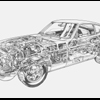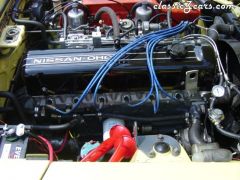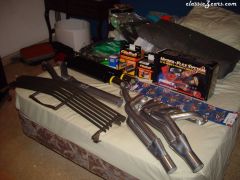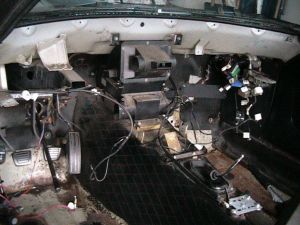Everything posted by wishihadaz
-
Centerline 17" wheels
- Centerline 17" wheels
Gentlemen- So we have a question of overall tire height/diameter vs. aspect ratio or profile. The overall height of a stock 175/70-14 is not significantly taller than a 205/50-15 or a 205/45-17 as this should be maintained for minimal speedometer error. Yes, their profiles are lower (sidewall height decreases) but the overall heights/diameters are not too different. But a 205/50-17 actually creates a taller overall height than stock, even though the profile is lower. Got it. If this is not clear, refer to the 10/10 tires link CDAVID suggested and see the comparisons.- New Jasper Remanufactured Engine
- Bodywork progress
- This must be a joke!
I can not believe what these brackets are going for. http://cgi.ebay.com/ebaymotors/Datsun-240Z-260Z-280Z-S30-Rear-Disc-Conversion-NR_W0QQcmdZViewItemQQcategoryZ33564QQitemZ8066132257QQrdZ1 I've seen entire rear kits, including the brakes and rotors for less than this price, and the seller gets a 100% rating?- Cam Grinders
Actually there are cam companies in the US who will grind to your specifications. Most simply advertise grinds that are popular to a wide range of buyers. I had a cam ground to my preferred 300/.500" many years ago.(A local shop in the Wash, DC area called RC Automotive) It ran absolutely fabulous. A cam is only as good as it's installer. There have been mixed opinions, on this site, about Schneider. There is a company called Paeco Industires, who specs cams to matched compression ratios and include a power range (they do everything!) . I'm am considering using them or Isky the next time around.- Custom bodies at the '06 Motorsport show
- Check Out My New Intakes!!
Well I guess that dispells the myth about smoothing out intakes. I have heard people say that the roughness is better for air fuel mixture. If Chino 240z got a 10hp increase, I guess polishing is a good thing. Now I'm curious as to how valuable a N36 intake is over just porting and polishing my stock intake on my "72" model. I just got outbid on ebay by $1 for a N36 that sold for $41! Please PM me on who does this.- race struts
Beautiful structural parts and craftsmanship. Personally done for you, or can the rest of us obtain them.- SU Carbs
Hey Glen, I'm not not going to trouble shoot on what I don't know about but, if you're running 2.8L with unmodified SU's they probably can't feed that displacement plus the cam lift and duration. In my research on this site, most people have to install larger needles. Additionally intakes are also swapped.(Somebody chime-in on which one...N36?) You might try www.rebelloracing.com for advice as they do SU rebuilds here in the states.- E88 not the best head?
Correct, I am referencing what I read in a L6 forum on HybridZ. Actually one of two forums on heads.- Who is Wishidadaz?
I don't post that often but I imput when I think it has relavence. I actually do have a Z (ZED) now. It is my second "72 240Z", a bit of an omen. Same year, originally painted that bright green/yellow #112, I think, and repainted black. I'm going to call her Ellenorz. Like Nick Cage in "Gone In 60 Seconds", I didn't have such good luck with my first encounter. You won't see any pics soon because there is a long way to go, but I will post before and after shots. Please take the time to read other posts by me and I invite your insight. Thanks, Larry Currence Wash, DC- E88 not the best head?
On the contrary! It depends on what that head is mated to, and if you plan on just bolting it together or modifying it. You have to consider what the sum of your build-up will consist of including induction, exhaust, and ignition.:stupid: The following is an except from one of the best "head forums" I have ever read. If you take the time to read this then I invite you to look at the L6 forum on our sister site HybridZ. ( By Paul Rushman) The biggest air flow restriction in the Datsun L-series head is the valve curtain area, i.e. the region between the valve head and the valve seat when the valve is OFF the seat. In all my L series engine builds, unshrouding the valves is always the first place I start. Even on mild street heads, I perform moderate valve unshrouding. Next, if the head is a square port head and will be used in a race only application I’ll widen the bowl to slow down the flow of air in this region. This allows the exhausting gasses to transition from the vertical plane out of the chamber to the horizontal plane on its way to the header with less chance of loosing the laminar air flow across the port floor. In dong this, the laminar air flow across the port floor will remain, (keeps the boundary layer intact), if this laminar flow separates from the port floor you will now have turbulence and this will restrict air flow considerably. (you may or not be able to catch this on a flow bench as a flow bench doesn’t measure the dynamic air flow in and out of the ports. I’ll expand on that at the end of this post). If the head has the round exhaust ports with the liners, all I do is blend the back of the valve seat into the liner. All of the heads I do, whether for street or full race, also receive a nice 5 angle valve seat, (sometimes only 4 angles can be performed do to space constraints), that I perform in house here at Rusch Motor Sports using Sunnen seat cutters, (I’ll be offering radius seats soon), and the valves are treated to a 30 degree back cut and the exhaust valves sometimes even get a nice little 45 degree chamfer on the chamber side of the head. All this extra valve and seat work mostly benefits air flow at low valve lifts, i.e. as the valves leave and return back to the seat itself. Here is my personal take on the L-series heads. E-31 and the early E-88 heads with the E-31 chambers are decent heads. They have the same potential as the other N-series heads when rules permit extensive carving. My opinion is the best place for the E-31 and the early E-88 is for a restoration project, or for a performance application where class rules dictate no material can be added to the chambers, no carving can be performed on the head and the update/backdate rules apply to the engine as an assembly, then these heads are a great choice. Now if you are not bound by those kinds of rules, you do have other choices available and being as the E-31 is becoming so rare now, these other heads are an easier option from a financial and availability stand point. The N-42 head is a great maximum effort race head if class rules allow extensive carving and welding to the head. In this case, weld the chambers, open the exhaust ports as described above, perform some serious valve unshrouding and “waa laa”, you now have a wonderful maximum effort race head that would SUCK on a street engine. (Side note; If you intend on having your valves unshrouded and have not done this type of work before, you are best served leaving this to a qualified experienced engine builder, preferably one that has been successful in extracting noticeable to impressive documented performance gains. If you are not sure what you are doing, do not attempt to unshroud the valves yourself. In experience can hinder the flow worse than what the heads were stock.) Of course there is more to building/machining/porting a maximum effort cylinder heading than just welding a chamber and/or unshrouding valves. There are items such as setting spring heights, clearancing the retainers, stem seals, and guides for the mega lift cam, deciding on just how far to go with oversize valves even to the extreme of offsetting the valve guides to allow even BIGGER valves if the cylinder bore permits, etc. The Z car N-47 head is a great street head. This head becomes almost ideal for the mild to hot street engine and even the mild to moderate race engine especially if the chambers can be welded up, (pretty much turns this head into the Maxima N-47 head which is a slightly more efficient chamber than the E-31). This “peanut” or “kidney” shaped chamber when used with flat top pistons or matching* dished pistons gives the ideal quench area which makes for a more efficient combustion process. To make use of this “kidney” shaped chamber on an L-28 running pump gas you will need matching* pistons. What I mean by “matching* pistons”, is a set of custom pistons from JE or other comparable source that has CnC the dish directly under the open portion of the “kidney” shaped chamber, not the entire surface area of the piston as is the OE 1975-1980 L-28 and all L-28-ET pistons. Any how, with this ideal squish, the engines optimum ignition advance will be less than the open chamber heads optimum ignition advance due to the more efficient chamber design. This happens because the flame front doesn’t have as far to travel to consume the entire air fuel mixture within cylinder, it now is in smaller area so the flame front doesn’t have to travel all the way to the other side of the cylinder during the ignition sequence. To better understand this concept, just visualize the open combustion chamber as being a flat wide circular disc, the diameter of the cylinder itself containing the air fuel mixture with the spark plug on one side, vs a small kidney shaped ball containing the same volume of air and fuel. Ideally a sphere shaped chamber with the spark plug in the dead center would be perfect, since that isn’t realistic, tuners just try and get as close to this ideal as possible. Some engines came for the factory much closer to this ideal, ala HEMI heads, etc. As for those round exhaust liners in the N-47 and P-79 heads, they actually flow VERY well. The liners offer a nice gentle radius as the air flow transitions from a vertical flow out of the chamber to the horizontal plane where it meets the header which keeps the air flow moving undisturbed even at high velocities where as the square ports with their really sharp short side radius doesn’t allow the air to make that transition with as much ease. What happens is the boundary layer of air along the port floor can and will separate causing the air to slam into the roof of the port and tumble along the floor of the port when the velocity gets high enough. This is not a good thing in the quest for power as this turbulence is very disruptive to air flow. This why we make that region of the port, the bowl, larger in an effort slow down the air flow to keep that laminar air flow across the port floor. Of course this only happens at very high velocities. Also, all L-series heads starting in 1977 have a slightly smaller intake port volume. What the engineers did was cast one side of the intake port wall with a “flat” in it, “D” shaped if you will. This reduction in cross sectional area starts approx ¾ of an inch into the port. This port shape is supposed to help bias the air flow as it enters the chamber more towards the middle of the combustion chamber itself, steering away from the chamber walls is passes the valve head. In theory this helps to reduce some of the air from slamming into the chamber walls of the combustion chamber. I don’t have enough hard evidence to back up this theory, but I do feel that this port bias does not detract from the performance potential of the cylinder head one bit. Now we get to the P-79 and P-90 heads. The combustion chambers of these heads are IDEAL, almost perfect once the valves are unshrouded. The only down side I see to the P-series heads, (and this down side is for the extremely radical ragged edge engines, not so much for the milder even hot race engines), is since the chambers are taller, (valves are now shorter as a result), the floors of both the intake and exhaust ports now have an even sharper short side radius and as stated previously, this is a detriment to flow as velocity increases. The transition from the horizontal plane to the vertical plane on the intake and vice versa for the exhaust, is not as smooth as the N-series and E-series heads. Now don’t take this as I am bad mouthing the P-series heads cause I’m not. I really like these heads for hot street and mild to moderate race applications. They are an inexpensive way to get the ideal squish using an OE flat top piston with a compression ratio compatible with pump gas. I have built several and will continue to build the P-90 and P-79 heads for street and mild race Z’s. What I’m saying in regards to the P-series from the stand point of building THE mega extreme N/A performance power house that is at the ragged edge of making useable power over a very narrow yet very high RPM range such as a best of the best N/A drag racing engine, these items should not be overlooked. Maxima N-47 head. What a darling mild race head this is. For mild to moderate race engines on a budget, using flat top pistons in an L-28, or even opting for pistons with a slight dome for greater than 13:1 compression, this is my go-to head. Just have your machine shop cut out the old intake seats and install the larger seats for the 1.73” or larger valves, have a competent Datsun engine builder/tuner unshroud the valves, blend the exhaust seat into the liner, and “waa laa”, a moderately high compression ratio race engine that will perform rather well up to 8000 RPM with the right cam, induction, and exhaust system. With a set of custom pistons machined so that the dish is directly under the open portion of that gorgeous peanut chamber, this head, in my opinion, makes for the perfect street head or mild race engine that runs pump gas. At the moderate level of race and above, I tend to prefer the N-42 with welded chambers and opened up exhaust ports. Now for that flow bench info I promised earlier on… Since a flow bench cannot duplicate the dynamics that are happening within the intake and exhaust tracts while the engine is actually running, i.e. sound pressure waves, pressure surges, exhaust heat, fuel enriched intake charge, valve overlap extraction, etc, flow bench numbers are nothing that should be used for comparing one head to another or bragging how good one thinks their head is! The best way to use flow bench numbers is using the SAME flow bench to compare ONE cylinder head for improvement after modifications have been performed, making note of any changes in air flow whether improvements were made or lost, nothing more. Flow benches do not represent what is actually going on within the intake tract OR the exhaust tract as mention previously, i.e. Dynamic air movement, pulses, waves, heat, etc!!!!. In real life, the valves are opening and closing causing the air to stop and move, stop and move, over and over and being as air has weight and is compressible, this constant surging will cause the pressures to rise and fall FAR above and below ambient. Depending on RPM, runner length, runner cross section, port shape, number of bends in the port and radius of those bends, valve shrouding, air density, cam timing in relation to the piston movement, (this has a HUGE effect on how the air gets moving within the intake and exhaust tracts, hence lopey idles, hard hitting powerbands, etc), there could be higher than ambient pressures at a particular RPM, i.e. a natural supercharging effect, that is why intake and exhaust runner lengths are TUNED! We have all seen where almost all Nascar engine builders have achieved over 110% volumetric efficiency on a naturally aspirated 2 valve engine by tuning the intake AND exhaust tracts to a specific RPM with specific runner cross section and runner lengths. This tuning is taking full advantage of the Helmholtz principle. Your basic garden variety flow benches do NOT and can NOT duplicate this, I’m not even sure if there is a flow bench made that can do this. The only real measure of how good a port can make HP, is to mount that head on an engine and run that engine on a Dyno, (and this is what we are REALLY after right, HP! Not just some arbitrary static flow number through a head port)! An example would be if one head that on one flow bench indicates it will outflow all the others tested, when all are attached to equivalent short blocks, the high flowing head could easily make LESS power on the dyno, but then again change the configuration a little with a different cam, intake tract, piston some shape, etc, the results would get even more confusing. Ok, I think I’m finished now. Inhale…… WHEW…….. Thank you all for allowing me to take up so much band width. Paul (BRRAP) Ruschman Rusch Motor Sports __________________ Paul (BRAAP) Ruschman Rusch Motorsports- Work wheels
See John C's comments about suspension travel and chassis dynamics when you go to 18" wheels (wheels, tires, suspension-forums). I'd have to agree; They look great great but you probably won't like the ride or performance. I wouldn't go larger than 17" and that is pushing it.- 15 X 8 @ 0 Too Much?
Here is yet another example of wide wheels that look great on a zcar. I'm not sure when this article was published but the example of the setup is good reference. http://www.superstreetonline.com/featuredvehicles/130_0507_240z/index.html- 15 X 8 @ 0 Too Much?
I've been researching Diamond wheels for their cost effectiveness, but I have found that they have 2 potential obstacles to covercome. 1. Their wheels must be balanced lug centric vs. hub centric.which is a problem for street applications and most tire shops. 2. Even with a 16x8 wheel, there a potential brake clearance problems because the inner rim dia. only winds up being 15". I'll be up-grading my rotors to a 4/4 setup and am concerned about that. The pic is of a guy who stretched 205's on an 15x8 rims! More on these wheels at HybridZ.- 5-bolt hub swap
I know you guys have heard this before but,there is a limited availability for nice wheels without going custom, for a 4-113 bolt pattern. Does switching to a 5 bolt hub solve the problem? There are a lot more z32 wheels available.- Dash Removed
WOW! That's frightening. I am going to have to do that at some point. Where are you going to send it to get it refinished?- Exhaust configuration advice
I ran across this car while doing some of my obsessively endless browsing. This guy is using a 3" mandrel bend exhaust with a Borla racing muffler. www.borla.com Listen to this and tell me what you think; You'll have to consider that he's blowing out a lot of air through that 3.2 liter stroker! http://www.bbgraphics1.com/73z/- bodykits.....
Here's another reference. www.kitcarz.com They have stuff from mild to WILD.- Rebuild Kits
I can't vouch from experience, but I have been compiling resources for rebuilds. I definitely would not buy anything from your local Autozone or anyone else becuase it's too easy to spec the wrong thing let alone quality. Most people overdo cam profiles and induction and you want to get it right the first time. Topend Perfomance and Rebello Racing seem to have the reputation for knowing about Zcars. A couple of other resources might be Paeco Industries http://www.paeco.com or Sunbelt http://www.sunbeltperformance.com They have a good rep too and they're closer to you. Good Luck:stupid:- Out of state purchases
I have a couple of prospects in the classifieds for this site. Here's the catch. I'll have to drive it home. Any ideas on procedures for out of state purchases.:stupid: - Centerline 17" wheels
Important Information
By using this site, you agree to our Privacy Policy and Guidelines. We have placed cookies on your device to help make this website better. You can adjust your cookie settings, otherwise we'll assume you're okay to continue.










